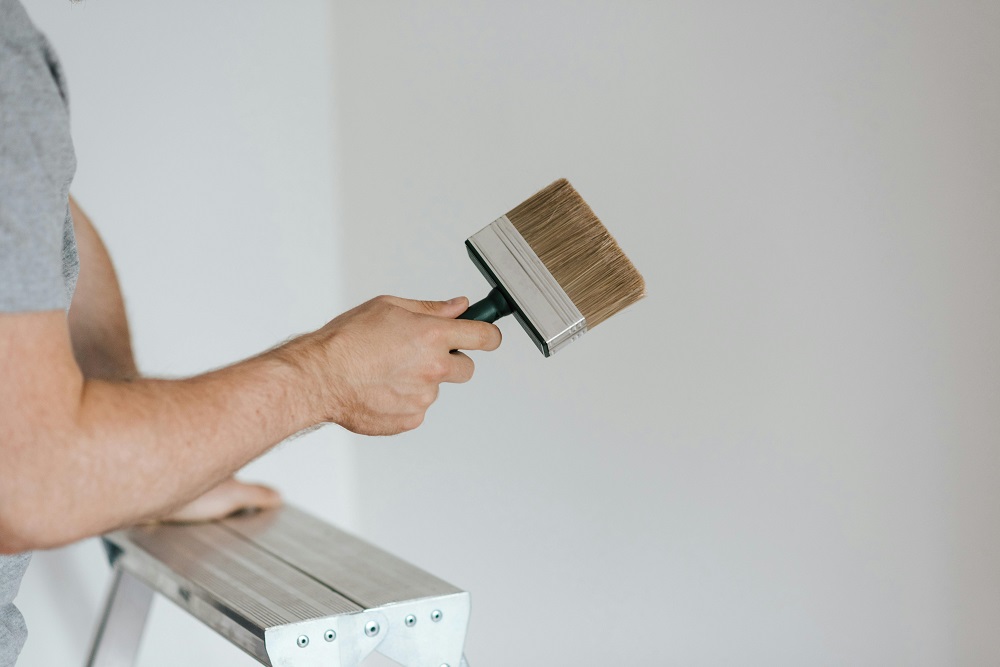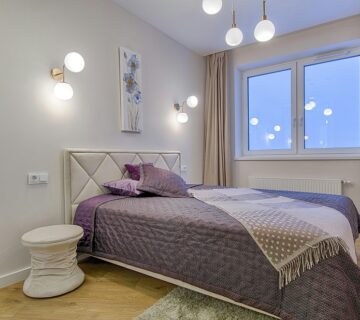When it comes to transforming the look and feel of your home, selecting the right paint finish is crucial. Paint finishes are the final layer of paint applied to a surface, and they play a significant role in both aesthetics and functionality. Each finish has unique characteristics that affect how light reflects off the surface, its durability, and its suitability for different types of spaces.
Why are paint finishes important in interior design and home decor?
- Aesthetic Appeal: Different finishes can dramatically change the visual impact of a room. For example, glossy finishes add a sleek, modern touch, while matte finishes offer a more subtle, sophisticated look.
- Functionality: Certain finishes are more durable and easier to clean, making them better suited for high-traffic areas like kitchens and hallways.
- Surface Imperfections: Some finishes can help conceal imperfections on walls, while others may highlight them.
In this article, we’ll explore the various types of paint finishes available. You will learn about their specific characteristics and where they work best. By understanding these details, you can make informed decisions on how to choose the right paint finish for your home, ensuring each room looks its best while meeting practical needs.
Understanding Different Types of Paint Finishes
A paint finish refers to the texture and sheen level of the paint once it dries on a surface. These finishes significantly impact the final look, feel, and durability of your painted surfaces. They can enhance or diminish certain visual elements, such as light reflection, wall imperfections, and the overall aesthetic.
1. Glossy Finish
Characteristics:
- High sheen
- Reflective surface
- Smooth texture
Where to Use:
- Doors
- Cabinets
- Trim
Pros:
- Easy to clean
- Highly durable
- Resistant to moisture
Cons:
- Highlights surface flaws
- Can appear too shiny for large wall areas
2. Matte Finish
Characteristics:
- Little to no sheen
- Soft, velvety appearance
- Non-reflective
Where to Use:
- Ceilings
- Bedrooms
- Living rooms
Pros:
- Hides imperfections well
- Offers a sophisticated look
- Less likelihood of showing marks or smudges
Cons:
- Harder to clean than glossy finishes
- Less durable in high-traffic areas
3. Semi-Gloss Finish
Characteristics:
- Moderate sheen
- Slightly reflective surface
Where to Use:
- Kitchens
- Bathrooms
- Trim
Pros:
- Easy to clean
- Durable against moisture
- Adds subtle shine without being overwhelming
Cons:
- Can highlight wall imperfections
- Not suitable for walls with many flaws
4. Eggshell Finish
Characteristics:
- Low sheen
- Subtle shine
- Smooth texture
Where to Use:
- Dining rooms
- Hallways
- Living areas
Pros:
- Durable against scuffs and marks
- Easy maintenance
- Provides an elegant finish
Cons:
- Slightly less washable than semi-gloss
- Can show minor imperfections over time
5. High Gloss Paint
Characteristics:
- Very high sheen
- Highly reflective surface
- Smooth and slick texture
Where to Use:
- Furniture
- Trim
- High-impact areas
Pros:
- Extremely durable
- Easy to clean
- Resistant to moisture
Cons:
- Amplifies surface imperfections
- Too shiny for large wall spaces
Understanding these different paint finishes helps you select the right one that matches your needs in both functionality and style. This ensures each room in your home not only looks great but also stands up to its specific demands.
Factors to Consider When Choosing a Paint Finish for Your Rooms
Selecting the right paint finish goes beyond personal preference and should be based on various factors such as:
1. Importance of Cleanliness and Durability
High-traffic areas like kitchens and hallways demand finishes that are easy to clean and durable. Semi-gloss and high-gloss finishes are excellent choices due to their washable nature, making them ideal for spaces where spills and scuffs are common.
2. Aesthetics and Mood Enhancement
Different paint finishes can significantly impact the atmosphere of a room:
- Matte finishes create a cozy, intimate setting with their non-reflective surface.
- Glossy finishes add an elegant, sophisticated touch, reflecting light beautifully.
Choosing the right finish can enhance the desired mood in each room.
3. Dealing with Imperfections
Walls often have imperfections that need to be either hidden or subtly highlighted:
- Flat and matte finishes are great for hiding imperfections as they do not reflect light.
- Glossy and semi-gloss finishes, on the other hand, can highlight imperfections but work well on smooth surfaces.
4. Practical Considerations for Wet Spaces
Bathrooms and laundry rooms require moisture-resistant finishes to prevent damage or mold growth. Satin or semi-gloss finishes are suitable for these areas due to their ability to withstand humidity and frequent cleaning.
5. Balancing Lifestyle Needs with Finishes
For homes with children or pets, choosing a finish that can endure frequent scrubbing is crucial:
- Eggshell or satin finishes offer a balance between durability and aesthetics, making them child-friendly options suitable for play areas.
These considerations help in selecting a paint finish that aligns with both functional needs and aesthetic preferences.
Room-by-Room Guide: Choosing the Perfect Paint Finish
Choosing the right paint finish for different rooms in your home is essential to achieve both style and function. Below are some recommendations tailored to specific areas, noting that personal preferences may vary.
Living Room
The living room is often a central gathering space, requiring a balance of aesthetics and durability.
- Eggshell Finish: This low-sheen finish offers a subtle shine that complements most decor styles. It’s durable enough to withstand occasional scuffs and marks, making it suitable for high-traffic areas.
- Matte Finish: If you prefer a non-reflective surface, a matte finish can provide a sophisticated look. Although less durable than eggshell, it hides imperfections well and is easier to touch up.
- Satin Finish: Slightly more reflective than eggshell, satin provides a smooth appearance and is easy to clean. Ideal if you have kids or pets, as it can handle frequent scrubbing.
Kitchen
Kitchens endure constant activity, spills, and splashes. The right finish should be easy to clean and moisture-resistant.
- Semi-Gloss Finish: Known for its durability and moisture resistance, semi-gloss is perfect for kitchens. It can withstand scrubbing without losing its sheen.
- Satin Finish: Offers a good balance between appearance and practicality. It’s easier to clean than eggshell but less shiny than semi-gloss, making it suitable for walls and cabinets alike.
- High Gloss Finish: While not commonly used on walls due to its tendency to highlight flaws, high gloss is excellent for kitchen cabinets or trim. It provides a sleek look and is highly resistant to stains.
Bathroom
Bathrooms require finishes that can handle high humidity levels without peeling or developing mold.
- Semi-Gloss Finish: Its moisture resistance makes semi-gloss ideal for bathrooms. It’s also easy to wipe down, which helps maintain cleanliness in this humid environment.
- Satin Finish: A good alternative if you prefer less shine. Satin finishes are still moisture-resistant and offer a smooth surface that’s easy to clean.
Bedroom
Bedrooms are personal spaces where comfort and tranquility are key. The finish should complement this atmosphere while being practical.
- Matte Finish: Provides a calm and cozy feel due to its non-reflective nature. Matte finishes also hide wall imperfections well but may require more maintenance over time.
- Eggshell Finish: Offers just enough sheen to give the walls some dimension without being too reflective. It’s durable enough for most bedroom activities while remaining stylish.
Considering these recommendations helps in understanding how different finishes can cater to both style and functionality across various rooms in your home.
Other Considerations in Selecting Paint Finishes
When choosing paint finishes, it’s important to consider how different finishes will work together in your home. Here are some things to think about:
Transitioning Between Finishes
Using different finishes in different areas of your home can help create a sense of flow and visual interest. Here are some tips for transitioning between finishes:
- Hallways to Rooms: Use semi-gloss or satin finishes in hallways for durability and easy cleaning. Transition to eggshell or matte finishes in living rooms and bedrooms for a more subtle look.
- Kitchens to Dining Areas: High-gloss or semi-gloss finishes work well in kitchens due to their resistance to stains and ease of cleaning. Transition smoothly into dining areas with a satin finish, which maintains some sheen but is less reflective.
- Bathrooms to Adjacent Spaces: Bathrooms benefit from high-gloss or semi-gloss finishes due to moisture resistance. Adjacent spaces like bedrooms or closets can use eggshell finishes, creating a balance between functionality and aesthetics.
Easily Cleanable Paint Finishes
In certain areas of your home, it’s important to choose paint finishes that are easy to clean. Here are some options:
- Opt for easily cleanable paint finishes such as semi-gloss and high-gloss in areas prone to dirt and grime, like entryways, mudrooms, and children’s play areas.
- Satin finishes also offer good cleanability with a softer appearance, suitable for family rooms and kitchens.
Ensuring these transitions are seamless helps create a unified look while accommodating the practical needs of each space. This approach not only enhances visual appeal but also ensures that your home’s design feels intentional and well-thought-out.
Notable Paint Finish Collections from Top Brands
Leading paint brands like Benjamin Moore offer an array of finish options, each tailored to specific needs and preferences. Here’s a closer look at some popular collections:
Benjamin Moore
- Matte Finish: Known for its washability and rich appearance, Benjamin Moore’s Matte finish is ideal for high-traffic areas like hallways and family rooms. It combines elegance with practicality, allowing walls to withstand frequent cleaning without losing their aesthetic appeal.
- Pearl Finish: The Pearl finish offers a slight sheen that adds a touch of sophistication to any room. It excels in high-traffic areas such as mudrooms or entryways due to its durability and ability to resist scuffs and marks.
- Satin Finish: While some homeowners might find the shine of Satin finish too pronounced for their tastes, it remains a popular choice for its easy-to-clean surface. It works well in kitchens and bathrooms where moisture resistance is crucial.
- Semi-gloss Finish: Semi-gloss is widely recommended for trim and doors because of its high durability and resistance to wear and tear. However, it’s worth noting that this finish can sometimes yellow over time, especially in areas exposed to little natural light.
- Latex Semi-gloss Finish: For those looking to avoid peeling on primed surfaces, Benjamin Moore’s Latex semi-gloss finish is an excellent choice. It provides a smooth, resilient coating perfect for trim work that requires frequent maintenance.
These finishes are just a sampling of what’s available from top brands, each designed to meet specific needs while offering superior quality and durability.
Essential Steps for Preparing and Painting with Different Finishes
Achieving a professional and long-lasting paint job involves more than just picking the right finish. Proper preparation and application techniques are crucial to ensure the best results, whether you’re tackling an initial painting project or doing future touch-ups.
Cleaning and Prepping Surfaces
Before you begin painting, it’s essential to clean and prep your surfaces thoroughly. This step is fundamental because dirt, dust, and grime can prevent the paint from adhering properly, leading to an uneven finish.
- Cleaning: Use a mild detergent mixed with water to wash the walls. For areas with significant grease or stains, such as kitchens, consider using a degreaser. Rinse the surfaces with clean water and allow them to dry completely.
- Sanding: Lightly sand the walls to smooth out any imperfections or rough patches. This process helps create a uniform surface for the paint to adhere to.
- Priming: Applying a primer is especially important if you’re working with new drywall, previously unpainted surfaces, or drastic color changes. Primer ensures better adhesion of paint, increases durability, and provides additional protection for the material being painted.
Applying Multiple Coats for Adequate Coverage
Once your surfaces are prepped and primed, it’s time to start painting. Achieving even coverage often requires multiple coats of paint.
- First Coat: The first coat serves as the base layer. It may not provide complete coverage but sets the foundation for subsequent layers.
- Second Coat: Apply a second coat after the first one has dried completely—usually within 4-6 hours depending on the type of paint used. This coat helps achieve full color depth and evenness.
- Third Coat (if necessary): In some cases, especially when covering dark colors or achieving a high-gloss finish, a third coat may be required for optimal coverage.
Techniques for Smooth Application
Using proper techniques during application can make a significant difference in the final look:
- Brush vs. Roller: Choose your tools based on the area you’re painting. Brushes are ideal for edges and trim work, while rollers are best for larger wall spaces.
- Consistent Strokes: Maintain consistent pressure and strokes to avoid streaks and lap marks.
- Edge Cutting: Start by cutting in around edges with a brush before filling in large areas with a roller.
By following these essential steps — cleaning, prepping surfaces, and applying multiple coats — you ensure that your paint adheres well and delivers a smooth, durable finish regardless of the chosen paint finish.
Maintaining the Beauty of Your Painted Walls
Regular maintenance is key to preserving the look and longevity of your painted walls. Here are some practical tips for maintaining different types of finishes:
Effective Touch-Ups
Touch-ups can be tricky, especially with varying paint finishes. Here’s how to ensure they blend seamlessly:
- Flat and Matte Finishes: These absorb more light, making touch-ups less noticeable. Dab a small amount of paint directly onto the blemish using a brush or sponge.
- Eggshell and Satin Finishes: Slightly more reflective, touch-ups should involve feathering out the new paint to blend with the existing coat. A small roller can be useful for this.
- Semi-Gloss and High-Gloss Finishes: These reflect a lot of light, highlighting any inconsistencies. Sand the area lightly before applying paint and use a high-density foam roller for an even finish.
General Maintenance Tips
Keeping your walls looking fresh doesn’t end with touch-ups. Regular upkeep ensures longevity:
- Dusting: Use a microfiber cloth or a vacuum with a soft brush attachment to remove dust regularly.
- Cleaning Agents: Avoid harsh chemicals that might damage the paint. Instead, use mild soap and water for cleaning spots and stains.
- Preventive Care: In high-traffic areas, consider using washable finishes like satin or semi-gloss to make cleaning easier.
Maintaining painted walls involves both routine care and occasional touch-ups. By following these guidelines, you can keep your walls looking pristine for years to come.
Conclusion
Choosing the right paint finish for your home involves understanding the specific needs and characteristics of each room. Rather than opting for a one-size-fits-all approach, consider factors like light reflection, traffic levels, and the desired aesthetic. The right choice can significantly enhance the overall appeal and longevity of your walls.
- Elevating A Space: The art of choosing paint finishes lies in selecting options that elevate your space while reflecting your personal style. Whether it’s a glossy finish in a high-traffic area or a matte finish for a cozy bedroom, each decision contributes to the unique ambiance of your home.
- Reflecting Personal Style: Paint finishes offer a way to express individuality. Glossy finishes can create a modern, sleek look, while eggshell or satin finishes bring warmth and comfort. Your choices should align with both functional needs and stylistic preferences.
Embrace this opportunity to thoughtfully select finishes that not only meet practical requirements but also bring your personal vision to life.
FAQs (Frequently Asked Questions)
What are paint finishes and why are they important in interior design and home decor?
Paint finishes are the final texture and sheen of a painted surface, which greatly contribute to the overall look and feel of a room. They are important in interior design and home decor because they can affect the perception of space, light, and color, as well as impact the durability and maintenance of the painted walls.
What are the different types of paint finishes available?
The different types of paint finishes available include glossy finish, matte finish, semi-gloss finish, eggshell finish, and high gloss paint. Each type has its own unique characteristics and is suitable for different areas within a home.
What factors should be considered when choosing a paint finish for different rooms?
When choosing a paint finish for different rooms, factors such as cleanliness, aesthetics, reflective surface, imperfections on walls, moisture resistance, and lifestyle needs should be taken into consideration. These factors will help determine the most suitable finish for each specific area.
How can I choose the perfect paint finish for different rooms in my home?
Choosing the perfect paint finish for different rooms in your home involves considering both style and function. For example, a living room may benefit from a matte finish to create a cozy atmosphere, while a kitchen may require a more washable semi-gloss finish due to high-traffic and cleanliness needs.
What are some other considerations to keep in mind when selecting paint finishes?
Additional considerations when selecting paint finishes include transitioning between different finishes in adjacent spaces or walls while maintaining a cohesive look throughout the home. It’s important to ensure that the chosen finishes complement each other and contribute to an overall harmonious aesthetic.
What are some notable paint finish collections from top brands?
Notable paint finish collections from top brands include Benjamin Moore’s Matte finish, Pearl finish, Satin finish, Semi-gloss finish, and Latex semi-gloss finish. Each collection offers unique products known for their quality and durability in terms of finish.





No comment